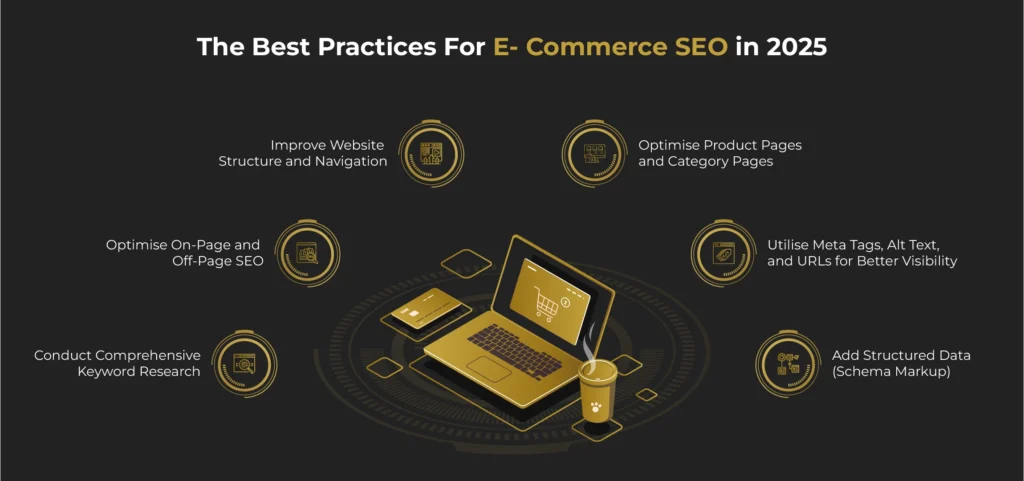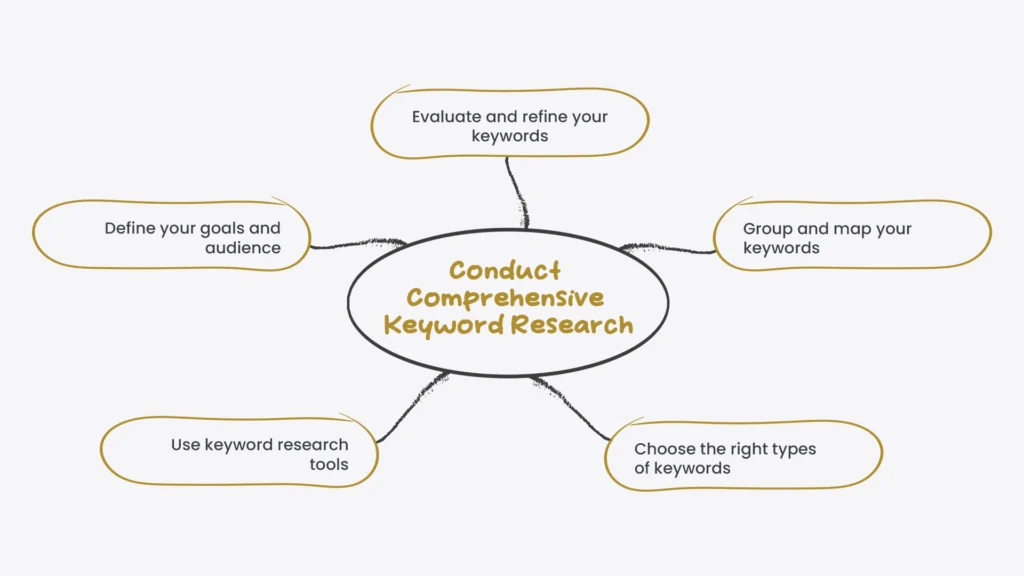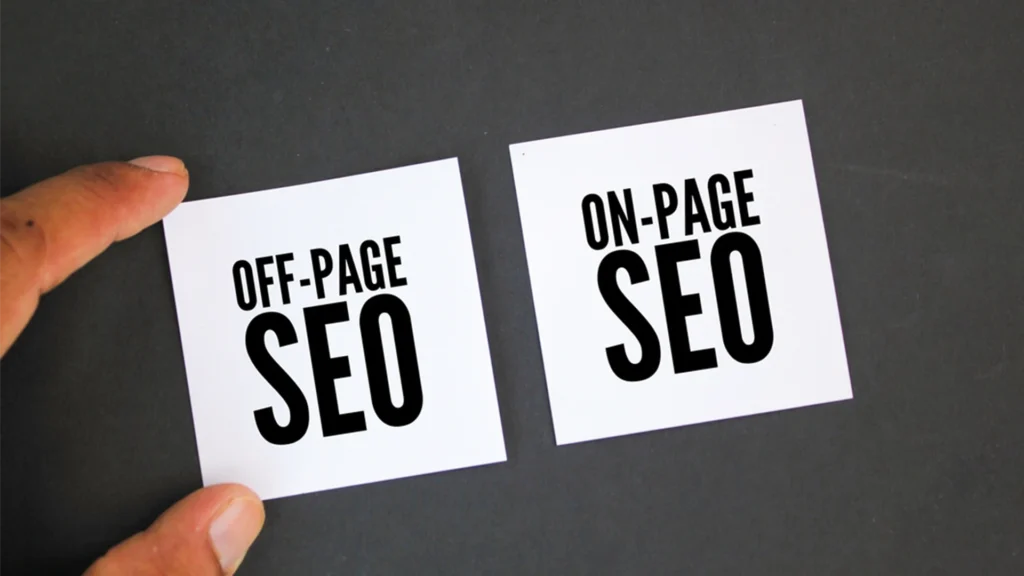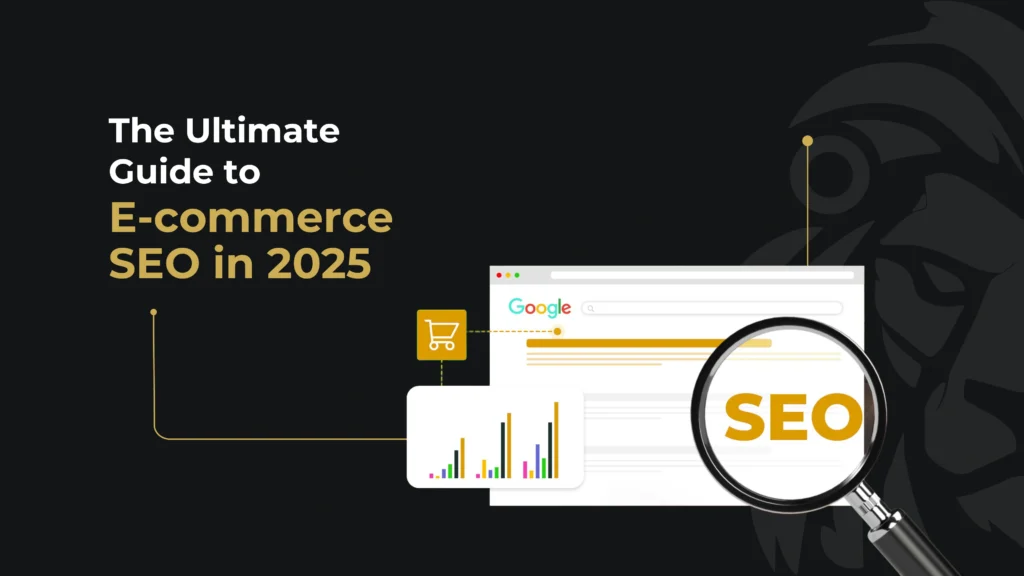If you want to improve the visibility of your online store, e-commerce SEO is a must. In the competitive arena of e-commerce, where thousands of websites battle for attention, SEO can be the difference between growing and stagnating.
In this article, you’ll learn everything you need to know about e-commerce SEO, alongside actionable strategies to optimise your store and improve its search engine performance.
Whether you’re starting from scratch or refining your existing efforts, this guide will help you achieve better rankings and deliver more value to your customers.
Key Takeaways
Before diving into the details, here are the main points you’ll learn from this guide:
- Understand E-commerce SEO Fundamentals: Learn what e-commerce SEO is, why it’s crucial, and how it differs from general SEO by focusing on product pages, category pages, and transactional keywords.
- Adopt Best Practices for E-commerce SEO: Explore proven strategies like conducting keyword research, optimising on-page and off-page elements, improving site structure and navigation, and enhancing product and category pages.
- Develop a Winning SEO Strategy: Understand how to build an effective e-commerce SEO strategy by outsourcing to agencies, prioritising content marketing and link building, and using analytics tools for ongoing optimisation.
- Achieve Long-Term Growth: See how integrating technical SEO, content creation, and strategic link building can transform your e-commerce site into a high-performing, customer-attracting powerhouse.
What is E-commerce SEO?
E-commerce SEO is the process of optimising an online store to improve its visibility on search engines like Google.
Unlike general SEO, which focuses on websites as a whole, e-commerce SEO zeroes in on product pages, category pages, and transactional keywords to attract potential buyers.
The goal of e-commerce SEO isn’t just to rank higher but to ensure your online store appears in front of the right audience at the right time.
This involves fine-tuning every element of your website—from product descriptions and images to technical aspects like site speed and mobile responsiveness.
For example, when someone searches for “best running shoes for flat feet,” an e-commerce site optimised for that keyword phrase can appear at the top of search results, offering the user a direct solution to their query.
Bottom line: E-commerce SEO is about aligning your online store with both search engine requirements and user expectations. When executed well, it can drive significant, sustainable growth for your business.
SEO Best Practices for E-commerce Websites
SEO for e-commerce websites isn’t easy, but it can be incredibly rewarding with the right strategies in place. A good starting point would be to adopt these proven SEO practices for e-commerce websites:

1. Conduct Comprehensive Keyword Research
Keyword research is the cornerstone of an effective SEO strategy. For e-commerce, it’s more than just targeting high-volume keywords. It’s about understanding buyer intent and selecting terms that align with the customer journey.
- Transactional Keywords: Focus on terms with strong purchase intent, like “buy organic skincare products” or “best gaming laptops under $1000.”
- Consideration Keywords: Target users who are in-market but not yet ready to buy by focusing on comparison and evaluation queries, such as “MacBook Air vs Dell XPS,” “best organic skincare brands,” or “Nike Air Zoom Pegasus review.”
- Informational Keywords: Target questions or queries users search before making a purchase, such as “how to choose the right running shoes.”
- Branded Keywords: Optimise for searches involving your brand name or product-specific terms, such as “Nike Air Zoom Pegasus review.”

Here are some pro tips to perform keyword research for your e-commerce website:
- Use tools like Ahrefs, Semrush, or Google Keyword Planner to uncover high-traffic, low-competition keywords.
- Analyse competitor websites for keyword gaps and opportunities.
- Group your keywords by intent (e.g., informational, navigational, transactional) and assign them to appropriate pages.
2. Optimise On-Page and Off-Page SEO
E-commerce SEO is built on two key pillars: on-page and off-page optimisation. Each plays a distinct yet complementary role in improving your store’s SEO performance.

On-Page SEO: On-page SEO involves optimising the elements within your website to align with user intent and search engine guidelines. Key practices include:
- Product Page Optimisation: Write unique, compelling product descriptions that emphasise benefits. For instance, instead of saying, “Made of stainless steel,” explain, “Crafted from durable stainless steel for long-lasting performance in any kitchen.”
- Internal Linking: Link to related products and categories to enhance navigation and distribute link equity.
- Keyword Placement: Include primary and secondary keywords in titles, headings, descriptions, and image alt text.
Off-Page SEO: Off-page SEO focuses on building your website’s authority through external signals. This includes:
- Backlink Acquisition: Collaborate with bloggers, influencers, and publishers to earn backlinks from credible sources.
- Social Proof: Encourage reviews and testimonials from satisfied customers to build trust.
- Social Media Engagement: Share content and interact with your audience on platforms like Instagram or Pinterest, which are often e-commerce goldmines.
3. Improve Website Structure and Navigation
A well-structured website ensures both users and search engines can navigate your store seamlessly. A clear hierarchy enhances user experience (UX) and helps search engines understand the relationships between pages.

Here are some best practices to keep in mind:
- Flat Architecture: Keep your site’s structure shallow, ensuring every page is accessible within 2-3 clicks. For example:
- Home > Category > Product
- Breadcrumb Navigation: Add breadcrumb trails like “Home > Women > Shoes > Running Shoes” to help users and crawlers understand page hierarchy.
- Logical Categories: Organise categories and subcategories based on product types or user intent. Avoid creating categories with overlapping or ambiguous terms.
For example, if you own an online clothing store, you could structure its navigation as follows:
- Main Categories: Men, Women, Kids
- Subcategories: Tops, Bottoms, Outerwear
- Specific Pages: Casual Shirts, Dress Shirts, Hoodies
4. Optimise Product Pages and Category Pages
Your product and category pages are the lifelines of your store. Optimising them ensures they rank well and provide the information users need to make purchasing decisions.
Product Pages:
- Compelling Descriptions: Highlight product features, benefits, and unique selling points. Avoid duplicating manufacturer descriptions, as this can hurt your rankings.
- High-Quality Images: Use multiple angles, zoomable images, and lifestyle photos. Optimise each image with descriptive alt text.
- Reviews and Ratings: Include customer reviews to build trust and add fresh content.
- Call-to-Action (CTA): Use clear CTAs like “Add to Cart” or “Buy Now.”
Category Pages:
- Introductory Content: Add a short description at the top of the page to introduce the category and its benefits.
- Internal Linking: Connect category pages to subcategories and related products.
- Faceted Navigation: Allow users to filter products by attributes like price, size, or color. Implement canonical tags to avoid duplicate content issues.
5. Utilise Meta Tags, Alt Text, and URLs for Better Visibility
Meta tags, alt text, and URLs are critical for improving search engine visibility and enhancing click-through rates (CTR).

Meta Tags:
- Meta Titles: Write concise, keyword-rich titles that match user intent. For example, “Shop Women’s Running Shoes | Lightweight & Durable.”
- Meta Descriptions: Include a short, compelling summary of the page’s content with a clear CTA. For example, “Find the perfect running shoes for every terrain. Free shipping on orders over $50.”
Alt Text: Image alt text helps search engines understand visuals and improves accessibility for users with disabilities. Use descriptive phrases like “Red hiking backpack with multiple compartments.”
URLs:
- Use clean, readable URLs that include primary keywords.
- Avoid long, complex URLs with unnecessary parameters.
- Example: www.store.com/mens-running-shoes (good) vs. www.store.com/product?id=12345 (bad).
Example in Practice: A product page for noise-canceling headphones might have the following:
- Meta Title: “Noise-Canceling Wireless Headphones | Crystal-Clear Audio”
- URL: /noise-canceling-headphones
- Alt Text: “Black wireless headphones with active noise cancellation.”
6. Add Structured Data (Schema Markup)
Structured data, also known as schema markup, is a powerful SEO tool that helps search engines better understand the content on your e-commerce website. This added detail can significantly boost your CTR and drive more qualified traffic to your site.

Schema markup helps search engines understand elements such as:
- Product details (e.g., name, price, availability).
- Customer ratings and reviews.
- Frequently asked questions (FAQs).
- Breadcrumb navigation.
When implemented correctly, structured data can make your listings stand out in search results by displaying additional information directly on the search engine results page (SERP). For example:
- Product Schema: Displays key product details like price, stock availability, and user ratings.
- FAQ Schema: Answers common customer questions directly in the SERP, making your listing more engaging and relevant.
- Breadcrumb Schema: Helps improve navigation by showing the hierarchy of your pages in the SERP.
You can use tools like Google’s Structured Data Markup Helper or plugins like Yoast SEO or Schema Pro to easily implement structured data on your e-commerce website.
How to Develop an Effective E-commerce SEO Strategy
Building a comprehensive SEO strategy for your e-commerce website involves leveraging a mix of services, tools, and techniques.
Here’s a breakdown of how to develop and sustain an effective approach:
1. Hire an Agency That Specialises in E-commerce SEO Services
For e-commerce businesses lacking in-house expertise or resources, outsourcing SEO services can be a game-changer. Agencies and consultants offer a wide range of solutions tailored to e-commerce needs, including:
- SEO Audits: A professional audit identifies technical issues (e.g., slow load times, crawl errors) and on-page optimisation gaps.
- Keyword Research: Agencies provide data-driven keyword strategies targeting high-intent search terms relevant to your products.
- Content Optimisation: Specialists craft optimised product descriptions, category pages, and blog content to improve rankings.
- Technical SEO: Services include fixing broken links, improving site architecture, and implementing structured data.
- Link Building: SEO professionals build authoritative backlinks through guest posts, partnerships, and digital PR campaigns.
Dominate Online offers all of the services listed above, tailored to meet the unique needs of e-commerce businesses. Click here to learn more about how Dominate Online can help you grow your e-commerce business.
2. Prioritise Content Marketing and Link Building
Content marketing and link building are essential pillars of a successful e-commerce SEO strategy. These elements drive organic traffic, establish your site’s authority, and build trust with your audience.
Content Marketing: High-quality, valuable content attracts and engages potential customers. In e-commerce, content marketing can take many forms:
- Blog Posts: Write posts that answer common customer questions, like “How to Choose the Right Running Shoes for Trail Running.”
- Product Guides: Create detailed buying guides that compare products and provide recommendations.
- Videos: Showcase product demos or tutorials, such as “How to Use Our Multi-Cooker.”
Link Building: Backlinks from authoritative websites signal trustworthiness to search engines. Focus on earning links from reputable sources within your niche:
- Guest Posting: Write articles for industry-related blogs that link back to your store.
- Influencer Collaborations: Partner with influencers who can review and link to your products.
- Digital PR: Develop shareable assets like infographics or research studies that other sites will link to.
Why It Matters: A strong backlink profile not only improves your rankings but also brings referral traffic from trusted sources.
3. Use Analytics and Tools for Ongoing SEO Optimisation
SEO is not a one-and-done process—it requires continuous monitoring and refinement. Analytics tools provide the insights needed to assess performance and make data-driven decisions.
Key Tools to Use:
- Google Analytics: Track user behaviour, traffic sources, and conversion rates.
- Google Search Console: Monitor indexing, resolve crawl errors, and analyse keyword performance.
- Ahrefs/Semrush: Evaluate backlinks, identify keyword opportunities, and monitor competitor strategies.
- PageSpeed Insights: Assess site speed and receive actionable recommendations to improve load times.
What to Track:
- Organic Traffic: Check if your traffic from search engines is growing over time.
- Conversion Rates: Analyse how well your SEO efforts translate into sales.
- Bounce Rate: Identify pages with high bounce rates and optimise them to retain visitors.
- Keyword Rankings: Monitor your progress for target keywords and adjust strategies as needed.
By consistently reviewing these metrics and adjusting your tactics, you can stay ahead of competitors and maintain a strong search engine presence.
Final Thoughts on E-commerce SEO
SEO for e-commerce websites requires a holistic approach that integrates technical optimisation, content creation, and strategic link building. By implementing the best practices outlined here—starting with robust keyword research and focusing on elements like site structure, product pages, and meta tags—you can create a store that ranks well and delivers exceptional user experiences.
Begin optimising today, and watch as your e-commerce site transforms into a high-performing, customer-attracting powerhouse.
If you’re ready to take your e-commerce business to the next level, Dominate Online is here to help. Built by business owners for business owners, we specialise in crafting results-driven strategies to grow your brand, build authority, and help you dominate your market. Discover how we can empower your business to thrive.
Ecommerce SEO FAQs
1. What are the most important ranking factors for e-commerce websites?
Search intent alignment, site speed, mobile responsiveness, and relevant content are crucial factors. Backlinks and user engagement metrics also play a significant role.
2. How do I avoid duplicate content on my e-commerce site?
Use canonical tags, create unique product descriptions, and avoid copying manufacturer descriptions verbatim.
3. Is link building necessary for e-commerce SEO?
Yes, backlinks from authoritative sites signal trust and improve rankings. They can also drive referral traffic to your store.
4. How often should I update my SEO strategy?
Regularly. SEO is dynamic, so revisiting your strategy quarterly helps you stay aligned with algorithm updates and shifting consumer behaviour.

